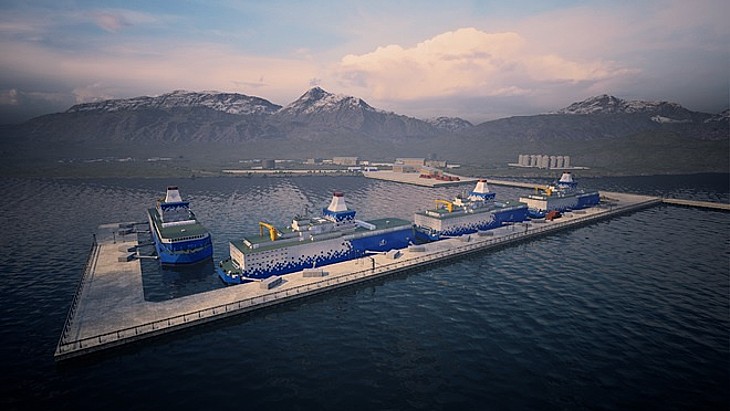Russian export push for floating nuclear power plants
16 June 2023
State nuclear power company Rosatom has signed an agreement with TSS Group to create a joint venture for the construction of a series of floating power units "with a capacity of at least 100 MWe and an assigned service life of up to 60 years for foreign markets and the subsequent sale of electricity from the floating power unit in the countries of presence".
 (Image: Rosatom)
(Image: Rosatom)The aim is to follow this framework agreement with legally and financially binding documents in the future. The fleet will use RITM-200M reactors, derived from those used on Russia's latest nuclear-powered icebreakers.
The agreement says that "as target markets, the partners consider the countries of the Middle East, southeast Asia, and Africa. Energoflot is expected to be put into operation in the period from 2029 to 2036".
Andrey Nikipelov, deputy director general for mechanical engineering and industrial solutions for Rosatom, said people within Russia and elsewhere had been studying its floating power plant development "with great interest" and they were now able to "offer the market a whole family" of floating power units with a range of power and uses and suitable for conditions ranging from the Arctic to tropical climates.
He said: "In addition to environmental friendliness and stable operation, floating nuclear power units are able to provide energy independence - both from the main power grids, and in a broader sense - protection from the volatility of energy markets ... floating power units have great commercial potential both in Russia and abroad ... and will create better living conditions for people and help economic development in different regions of the world."
Sergey Velichko, chairman of TSS Group, an oil and gas construction and engineering specialist, said the need for low-carbon energy generation was "becoming more and more urgent in the world - customers need a stable, economically predictable and sustainable source of energy". He added that floating nuclear power plants can meet that need and "allows the client to receive as much energy as he needs and in what place" and is "an investment in a future that is more environmentally friendly and predictable for us and our children".
Rosatom is already in the process of constructing four floating power units for the Baimskaya ore zone which highlights floating nuclear power plants' ability to be transported to hard-to-reach areas. It said: "In countries with developing economies, affordable energy is the key not only to the dynamic development of industry but also a factor in the growth of the well-being of the population."
Construction began last August, at a Chinese shipyard, of a barge that will later be fitted with two RITM-200M reactors for the first of the four floating nuclear power plants for the Cape Naglounyn project which will power the mining development at Baimskaya in the Russian Arctic. It will supply 103 MWe but, as the development requires 300 MWe, three are needed, with a fourth to be installed as backup for refuelling and maintenance.
Russia already has one floating nuclear power plant, the Akademik Lomonosov, which is stationed at Pevek where it supplies heat and power to the town. This is based on two KLT-40S reactors generating 35 MWe each, which are similar to those used in a previous generation of nuclear powered icebreakers. So-called 'modernised floating nuclear power plants' like the ones for Cape Nagloynyn feature reactors from the new RITM series, as used in the latest generation of icebreakers. RITM units can also be used on land and a single-reactor plant is planned for Ust-Kuyga in Russia's far east.
Researched and written by World Nuclear News
No comments:
Post a Comment